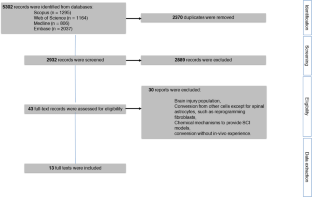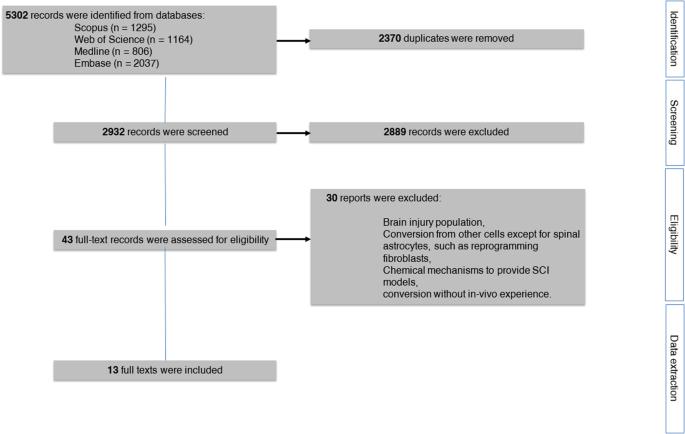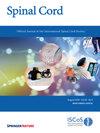脊髓损伤中星形胶质细胞向神经元样细胞的重编程:系统综述。
IF 2.1
4区 医学
Q3 CLINICAL NEUROLOGY
引用次数: 0
摘要
研究设计:系统综述 目的:确定在脊髓损伤(SCI)动物模型中体内将星形胶质细胞重编程为神经元样细胞的疗效:确定在脊髓损伤(SCI)动物模型中将星形胶质细胞体内重编程为神经元样细胞的疗效:方法:采用 PRISMA 2020 指南,并使用 Medline、Web of Science、Scopus 和 Embase 等搜索引擎,直至 2023 年 6 月。方法:采用PRISMA 2020指南,在Medline、Web Science、Scopus和Embed上进行搜索,搜索时间截止到2023年6月。纳入了在所有动物模型中使用任何载体将星形胶质细胞转化为神经元样细胞效果的研究,但排除了除脊髓星形胶质细胞以外的其他细胞转化、提供SCI模型的化学机制、脑损伤人群以及无体内经验的转化。对偏倚风险进行了独立计算:初步确定了 5302 篇稿件,经过资格评估后,有 43 项研究被纳入全文分析。经过最终分析,共纳入 13 篇稿件。所有研究均被评为高质量研究。转导因子Sox2、Oct4、Klf4、成纤维细胞生长因子4(Fgf4)抗体、神经原分化1(Neurod1)、锌指蛋白521(Zfp521)、人参皂苷Rg1和小分子(LDN193189、CHIR99021和DAPT)能有效地将星形胶质细胞重编程为神经元样细胞。p21-p53或Notch信号敲除、丙戊酸或硫酸软骨素蛋白多糖抑制剂可增强这一过程。成熟神经元的类型既有兴奋型也有抑制型:结论:在脊髓损伤后的动物模型中,星形胶质细胞重编程为神经元样细胞似乎很有前景。结论:在脊髓损伤后的动物模型中,星形胶质细胞重编程为神经元样细胞似乎很有前景。星形胶质细胞重编程后的分子和功能改善已在体内得到证实,该领域还需要进一步研究。本文章由计算机程序翻译,如有差异,请以英文原文为准。


Reprogramming of astrocytes to neuronal-like cells in spinal cord injury: a systematic review
A Systematic Review To determine the therapeutic efficacy of in vivo reprogramming of astrocytes into neuronal-like cells in animal models of spinal cord injury (SCI). PRISMA 2020 guidelines were utilized, and search engines Medline, Web of Science, Scopus, and Embase until June 2023 were used. Studies that examined the effects of converting astrocytes into neuron-like cells with any vector in all animal models were included, while conversion from other cells except for spinal astrocytes, chemical mechanisms to provide SCI models, brain injury population, and conversion without in-vivo experience were excluded. The risk of bias was calculated independently. 5302 manuscripts were initially identified and after eligibility assessment, 43 studies were included for full-text analysis. After final analysis, 13 manuscripts were included. All were graded as high-quality assessments. The transduction factors Sox2, Oct4, Klf4, fibroblast growth factor 4 (Fgf4) antibody, neurogenic differentiation 1 (Neurod1), zinc finger protein 521 (Zfp521), ginsenoside Rg1, and small molecules (LDN193189, CHIR99021, and DAPT) could effectively reprogramme astrocytes into neuron-like cells. The process was enhanced by p21-p53, or Notch signaling knockout, valproic acid, or chondroitin sulfate proteoglycan inhibitors. The type of mature neurons was both excitatory and inhibitory. Astrocyte reprogramming to neuronal-like cells in an animal model after SCI appears promising. The molecular and functional improvements after astrocyte reprogramming were demonstrated in vivo, and further investigation is required in this field.
求助全文
通过发布文献求助,成功后即可免费获取论文全文。
去求助
来源期刊

Spinal cord
医学-临床神经学
CiteScore
4.50
自引率
9.10%
发文量
142
审稿时长
2 months
期刊介绍:
Spinal Cord is a specialised, international journal that has been publishing spinal cord related manuscripts since 1963. It appears monthly, online and in print, and accepts contributions on spinal cord anatomy, physiology, management of injury and disease, and the quality of life and life circumstances of people with a spinal cord injury. Spinal Cord is multi-disciplinary and publishes contributions across the entire spectrum of research ranging from basic science to applied clinical research. It focuses on high quality original research, systematic reviews and narrative reviews.
Spinal Cord''s sister journal Spinal Cord Series and Cases: Clinical Management in Spinal Cord Disorders publishes high quality case reports, small case series, pilot and retrospective studies perspectives, Pulse survey articles, Point-couterpoint articles, correspondences and book reviews. It specialises in material that addresses all aspects of life for persons with spinal cord injuries or disorders. For more information, please see the aims and scope of Spinal Cord Series and Cases.
 求助内容:
求助内容: 应助结果提醒方式:
应助结果提醒方式:


